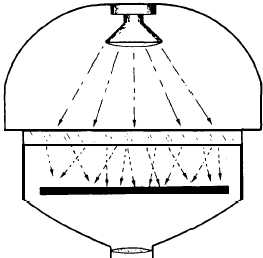Figure 11-8.–Condenser enlarger.
of carrier is a holder where the negative is placed
between two sheets of glass. This type of holder is used
for larger negatives since they have a tendency to sag in
the center when they are not supported by glass.
The lens used in an enlarger should have an angle
of field large enough to cover the negative being printed.
A lens with a focal length approximately equal to the
diagonal of the largest negative to be printed provides
sufficient angle of field.
The bellows of an enlarger should be capable of
extending at least twice the focal length of the lens. This
amount of bellows extension is necessary for making
1:1 reproductions. Although it is possible to make
reductions to any desired size, the bellows on most
enlargers cannot be extended far enough to make
reductions smaller than 1:1. Smaller reductions can be
made by using a longer focal-length lens, but a better
method is to use a reducing attachment. A reducing
attachment consists of a section of supplementary
bellows fitted with a longer focal-length lens.
The systems used to distribute the light evenly over
the negative divide enlargers into three general
types–condenser, diffusion, and condenser-diffusion
enlargers.
CONDENSER ENLARGERS
A condenser enlarger has a set of condensing lenses
between the light source and the negative. The
condensing lenses concentrate or focus the light from a
light bulb and direct the light rays straight through the
negative to the lens (fig. 11-8).
Figure 11-9.–Diffusion enlarger.
The condenser lenses are a pair of planoconvex
lenses mounted as a unit with their convex surfaces face
to face. A condenser enlarger produces a sharp, brilliant
image and produces higher contrast and detail than
diffusion enlargers. Negative defects and scratches are
more apparent in the print when made on a condenser
enlarger.
The characteristics of a condenser enlarger are as
follows:
It produces maximum tone separation.
It is suitable for making prints to a high degree
of enlargement, because of its optical
characteristics.
It produces a higher image contrast with a given
negative than printing with a diffusion enlarger.
It is not recommended for negatives that have
been retouched, because the edges and ridges of
the retouched areas may print as dark lines.
It may be used to emphasize negative defects and
silver grain structure.
DIFFUSION ENLARGERS
A diffusion enlarger has a diffusion screen (usually
ground or optical glass) between the light source and the
negative. Light from the lamp, as well as the light
reflected from the reflector of the lamp housing, falls on
the diffuser that scatters the light. After the light passes
through the diffuser, it travels in many directions when
it falls upon the negative (fig. 11-9).
11-10




